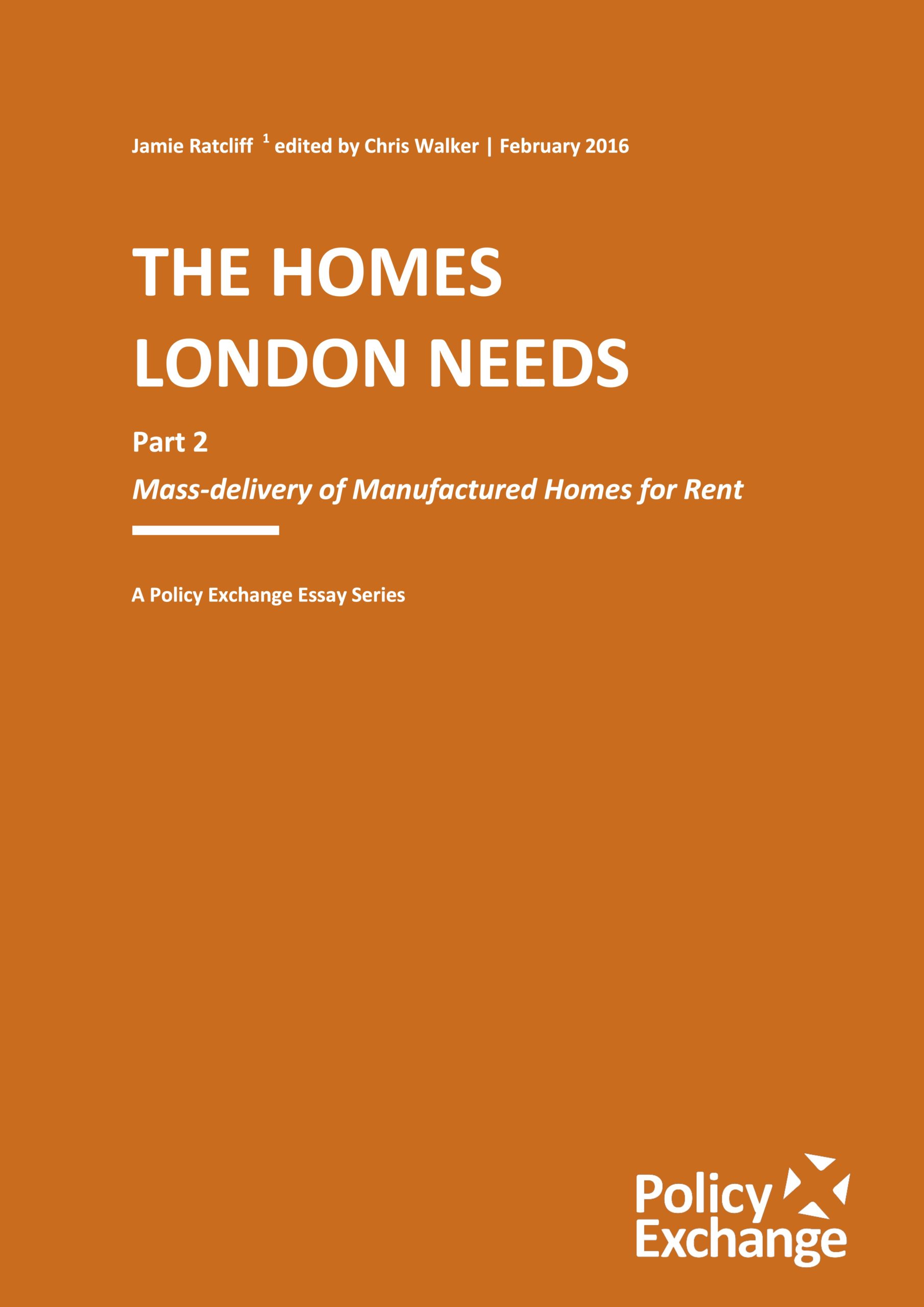
The Homes London Needs: Part 2
At its simplest, just three things are needed to build homes: land, funding and demand. What is needed is a new way of building homes which could provide the first two in abundance. London does not need any help with the third.
In order to guarantee success, Government needs to make bold changes to the laws surrounding compulsory purchase of empty or under-utilised (surplus) commercial properties to create a significant supply of land for new housing. It should also provide significant up-front investment match-funded with private sector equity funding to pay for the land acquisition, land redevelopment and large scale house building.
Bringing forward land for housing in this way would fundamentally be about rebalancing land use in our Capital, helping the land market to adjust more quickly to the growing demand for housing use and declining demand for other uses – most notably industrial. Prominent examples include the redevelopment of Docklands in the 1980s and, more recently, the Olympic Park.
There are actually two blockages that prevent London from dramatically increasing the supply of new homes: (i) a lack of land availability for new housing and (ii) a lack of innovation and capacity in the housebuilding sector.
Lack of land availability
It is unfair simply to criticise the planning system for not brining forward enough land for housing. Planning approvals have been running at an average of 55,000 homes a year for the last ten years, over double the rate of housing completions (27,000) and more than the homes London needs (50,000). But it is obviously too simplistic to say that the supply problem is solved from a planning point of view. Many of the planning permissions will be on very large sites, which at typically slow build-out rates will take decades to complete.
Traditional house builders’ ‘build for sale’ business model is fundamentally reliant on margins and not volumes. This is necessarily so, to maximise profits as well as manage the risks and uncertainty inherent in the London (and UK) housing market, most notably the cyclical risk. The affects their willingness to build out quickly.
One issue then with London’s supply is a lack of contingency of land identified and earmarked for development. When producing a local development plan, Local Planning Authorities are required to identify only sufficient land for the homes that need to be built in their area and no more – i.e. the quantum of land identified in London is for 420,000 over 10 years – whereas we probably need far more than that to ensure that 420,000 actually get built.
Another issue is implicit in the ‘build for sale’ model and its associated low market absorption rate, a key factor behind slow build out rates on large sites. Yet new build private rented homes can be absorbed into the market at up to fifteen times faster than new build homes for sale .
London is not full. It remains a relatively low density city with plenty of land suitable for increased housing provision. Just look on Google Maps in or around central London and you won’t fail to be struck by the vast swathes of vacant or under-used land, used for surface car-parking, storage or warehousing.
Industrial land could, over time, make a significant contribution. There are 6,899 hectares of industrial land in London and some of this land could be used for housing through a change of land use. As a start, there are 543.5 hectares of vacant industrial land, enough for nearly 70,000 homes. London continues to deindustrialise – according to a report produced for the GLA, the amount of industrial land declined by 9.4% in the 10 years to 2011 alone.
Lack of innovation and capacity
Homes in 2015 are more or less built using the same methods they were 150 years ago. This is largely because homes are hand-built, using labour intensive methods, in largely uncontrolled conditions. These construction methods are inefficient, slow, require interaction by a large number of different trades, and are negatively affected by adverse weather.
As if such low-productivity was not enough, there is also an acute skills shortage in the housebuilding industry. The skills problem is actually a longstanding one, though exacerbated periodically by economic downturns. According to EC Harris even at the height of recruitment in 2005 the construction industry was not attracting sufficient new entrants to replace the 700,000 workers who were due to retire within the next ten years.
To deal with these problems this essay proposes two things: (i) enhanced compulsory purchase powers to acquire land and (ii) supporting off-site manufacture of homes to drive innovation and overcome skills shortages, as well as enable rapid build out rates. By combining these factors, the Government would create an investible proposition for equity funds to invest in homes for rent and part-rent (shared ownership).
Enhanced CPO powers to acquired land
The GLA already has powers to requisition privately owned land, with compensation to the owners, through compulsory purchase. But not only is the process long and drawn out, the compulsory purchase price is usually at market value under the new use – where applicable – plus compensation for any upheaval. This makes compulsory purchase very expensive: to illustrate, a plot of industrial land (i.e. at existing use) worth £3,000,000 might instead be worth £5,000,000+ if used as residential land. There are also very limited grounds for using compulsory purchase powers for housing purposes and the process can take years and years.
To assimilate the land for contingency housing that is needed, the Mayor of London should be given enhanced compulsory purchase powers. The Mayor should be empowered to purchase land at current use value and to acquire it quickly (i.e. with fewer grounds for challenge), where the business premises have been empty, or the land disused, for a certain period of time (e.g. 2 years), applying the “use it or lose it” principle. The current land uses would include all non-residential uses – e.g. industry, storage and warehousing, retail and offices, as well as other land use such as carparks.
Supporting off-site manufacture of homes to drive innovation and overcome skills shortages
To overcome the house-building sector’s capacity constraints as well as to deliver new homes at scale and pace requires a new construction method – of homes manufactured in factories, or so-called off-site manufacture. The approach sees components or modules precision-manufactured in factories before being assembled like a high-tech jigsaw on site. This approach would allow standardisation but with sufficient variability to ensure it did not result in uniformity. Design codes or ‘pattern-books’ could even be adopted within each of the redevelopment areas (i.e. where land had been released for housing from a different use previously) with the input from local people.
These homes would not be like the ‘prefab’ homes of the 1960s. Modern manufactured homes can be clad in a variety of materials including bricks and are therefore visually indistinguishable from homes made from more traditional methods.
Investible proposition for equity funds to invest in homes for rent
By combining rapid land acquisition through compulsory purchase, as well as a rapid build out rate of new homes using off-site manufacture at a scale, this new form of housing delivery model in London could harness the strong growth potential of purpose-designed apartment blocks of build for rent homes. This could be funded by the ‘wall of equity’, as London seeks to grow its institutional private rented and shared ownership sectors.
Pension funds and other large investors are increasingly either buying up blocks of existing rental accommodation or embarking on so-called “build to rent” – a trend familiar to investors and tenants in the US, Canada and continental Europe, but not in the UK. These purpose-built, large-scale properties (typically apartment blocks) offer longer-term tenancies, more predictable rents and shared services.
But upfront Government investment would also be intended to catalyse this new form of housing delivery and investment, to provide the pioneering needed to “try and test” the model.
Government or the Mayor of London should therefore contribute repayable funding to a private/public joint venture with an institutional investor (or group of investors). The joint venture would provide upfront funding to acquire the land, probably through the new compulsory purchase powers (as described above). The joint venture would also pay to remediate the land, put the site infrastructure in place, master-plan the site and obtain planning permission, as well as commission an off-site homes manufacturer or a number of them to build the homes.

